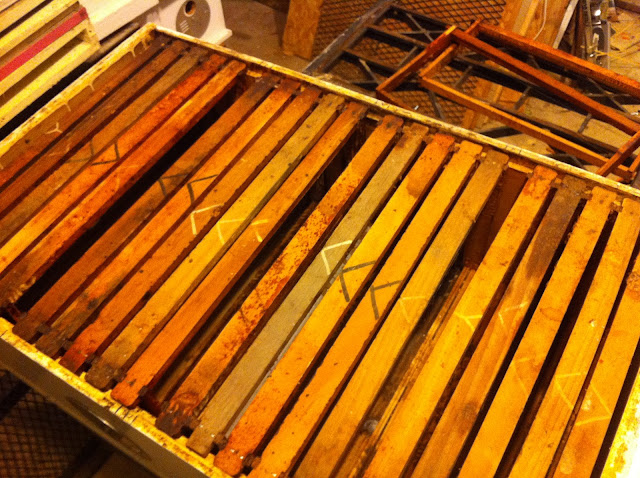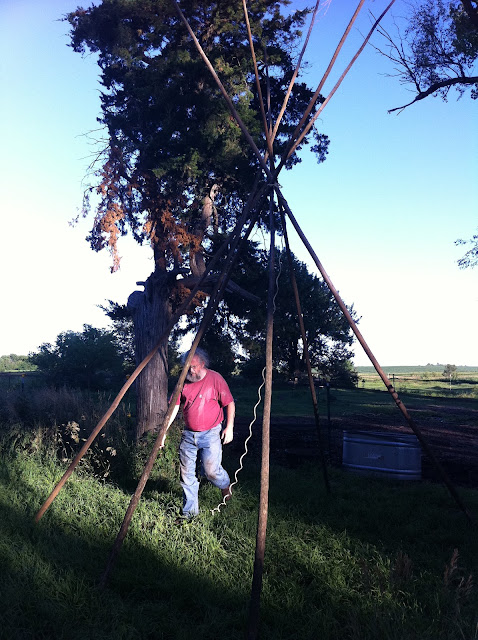This past week, (the last week of June 2011) I went to visit the Michael Bush, a beekeeper of some renown among the online beekeeping forums. If you read my blog here, you’ve seen me quote him and link to his website on quite a number of occasions.
It was an excellent opportunity to see how another beekeeper works and to experience the methods he has written about first hand. I thought I’d explore them and discuss some pros and cons for an up close view of his methods. Like many beekeepers familiar with Mr. Bush’s work, I was one who had read his website, viewed his pictures, and pondered his results, but had never seen them in person. Now having seen them in person, I can more accurately decide which of his ideas to try and to weigh the options in a more enlightened fashion.
First, I’d like to discuss Mike’s use of eight frame mediums almost exclusively for all his normal hives. His standard configuration is eight frames of PF-120 (Mann Lake Ltd.) and a single frame of Perma-comb. This results in a box in which there is no space for the frames to move around and everything fits near perfectly. Also with the PF-120’s are foundationless frames but they’re not quite as numerous.
The first thing that struck me about this method is the way the hive is setup in units. In my hives with ten frame deeps, a frame is a unit. In Mike’s hives, a box is a unit. Therefore, his walkaway splitting technique is to make two bottom boards empty and deal the boxes from a hive back and forth on those two bottom boards. So each hive now consists of every other box from the original hive. To make up the size, he places a few empties on the bottom, or sometimes on the top. With this method, one doesn’t look at the individual frames, nor does one need to. I had to have a look just for funsies, but it wasn’t necessary. I doubt splitting has ever been faster.
The PF-120’s contribute fantastically to Mr. Bush’s method. His method requires far less work than the standard beekeeping method. There is no frame wiring or foundation installing. If a hive has died and sat around for years getting full of wax moths, all you need to do is pull the frame out, and peel off the layer of webs. It’s almost exactly like removing the lint from the lint trap in your clothes dryer. The foundationless frames are just as easy. The Perma-comb frames need almost no care at all. Put it back together, and the box-unit is good to go.
Mike also has a couple of top bar hives of which one was in operation when I was there. It has a beautiful and prolific Carniolan queen heading it up, and the hive was beautiful. Here’s a picture of me finding the queen.
And here she is.
Mr. Bush has also experimented with just about every other standard and nonstandard equipment style there is and he has plenty of scraps of old hives and equipment to prove it. I saw a Dadant-deep style hive in person for the first time, as well as such others as 12 frame deeps, observation hives, several types of pollen traps, long hives of 40 frames or more, nucs from 2-10 frames, and everything I’ve ever read about on his website.
So, after trying Mike’s 8 frame deep system, I have a few criticisms from my perspective. Firstly, an 8 frame hive must be stacked especially tall for higher honey production. Mike can’t do this, nor can I due to high winds, especially for him. But his focus is not honey production, it’s queen production, so it works very well. I do like the way a box is a unit that doesn’t need to be messed with, but I prefer the ten frame style for the stacking ability. Also, since the frames are packed in pretty tight, it’s hard to pull them out without rolling a bunch of bees. Again, this works well for him but not for me.
One other downside is the cost. Medium boxes and frames cost only slightly less than deeps, and the same goes for 8 frame. All the same cuts need to be made on each piece of woodenware and only slightly less wood is used, so there is no cost benefit, and in fact, the reverse is most often true. For a certain amount of money, you get more square inches of comb with a ten frame deep hive than pretty much any other configuration.
I am considering eventually making the switch to ten frame mediums. I like them because they are lighter, and because splits can be made without concern for where the queen is. Mike was even so gracious as to let me borrow some ten frame plastic mediums and frames to try out. Someone gave them to him to evaluate, but since he doesn’t use ten frame equipment, he hasn’t yet. So, I’m going to try them out and build some wooden ones and see how it works. If I like them better, I’ll switch. I don’t enjoy lifting or carrying deeps full of honey, and my extractor only holds 9 deeps but 18 mediums. Also, I have a sneaking suspicion that mediums extract much better than deeps and blow out less. I also think they’ll have fewer problems with foundation buckling.
Overall, his system is perfect for what he’s doing. The rapidity with which his out yards can be processed is amazing. The heaviest boxes don’t require straining to move. Splitting is straightforward and speedy. When I convert, it will be far easier to convert from deeps to mediums than it will be to convert from 10 frame to 8 frame. Furthermore, I really think ten frame is what is right for me, and that’s what each beekeeper needs to decide for themselves. What is right for you? Spend the time doing the research and figure out exactly what you want and need. My advice for all is to never get your bees in the same year you decide to become a beekeeper. I think I need a separate post for ‘how to start beekeeping.’ Maybe soon.
Aside from the boxes and frames, the most important thing Mike is doing is keeping bees treatment free. His bees are treated with nothing, absolutely nothing. He is the most visible and vocal proponent of treatment free beekeeping, and he has shown for years that it works and even works on a large scale.
For those of you that have been asking for Mike to write a book, never fear.
It will soon be here. He’s spent a lot of time organizing what he’s written online into book form. You can still find the vast majority of it online though, and he’s happy to tell you that. But, there’s nothing like having something solid in your hands to read. I was helping him proofread it this week, and it is quite good. Look for it in hardback soon and in a three part ‘beginner, intermediate, advanced’ paperback edition as well.
Mike was kind enough to host me and another beekeeper this week. He put up a tipi for us to stay in. I enjoyed it. Here he is putting it up.
Here is the finished product.
It was a great opportunity to see Mike’s operation, as limited as it is in scope at this time. Next year, he’s going to be ramping up into full time queen production. His queens are expensive, but I’d say they’re well worth it and I plan to be proving it with my wallet. Next year, I’m planning on going back and learning his queen rearing techniques. Thanks again Mike!
Oh, one last thing. The area around Mike's place is beautiful. I mean, other than the corn and soy beans.





































